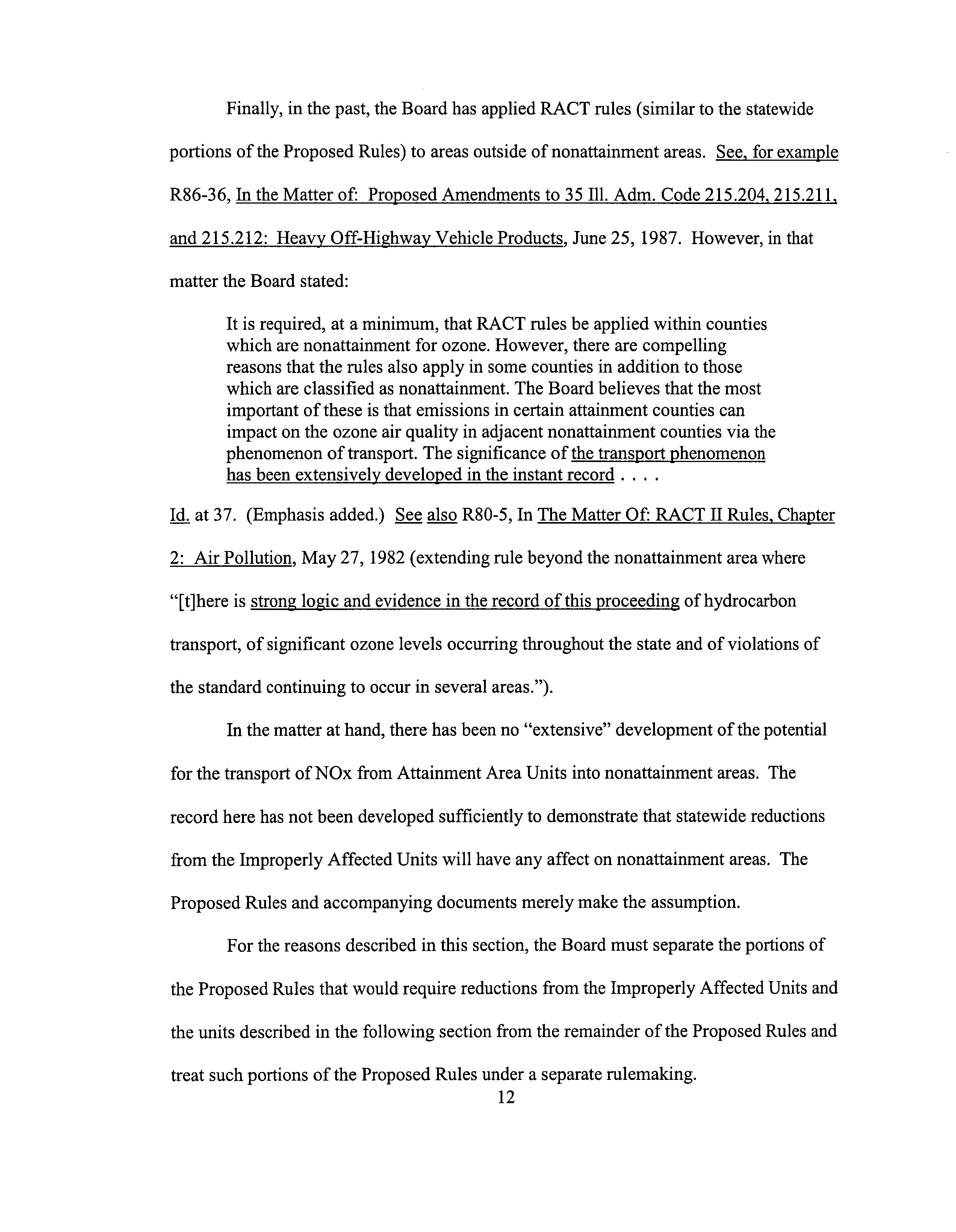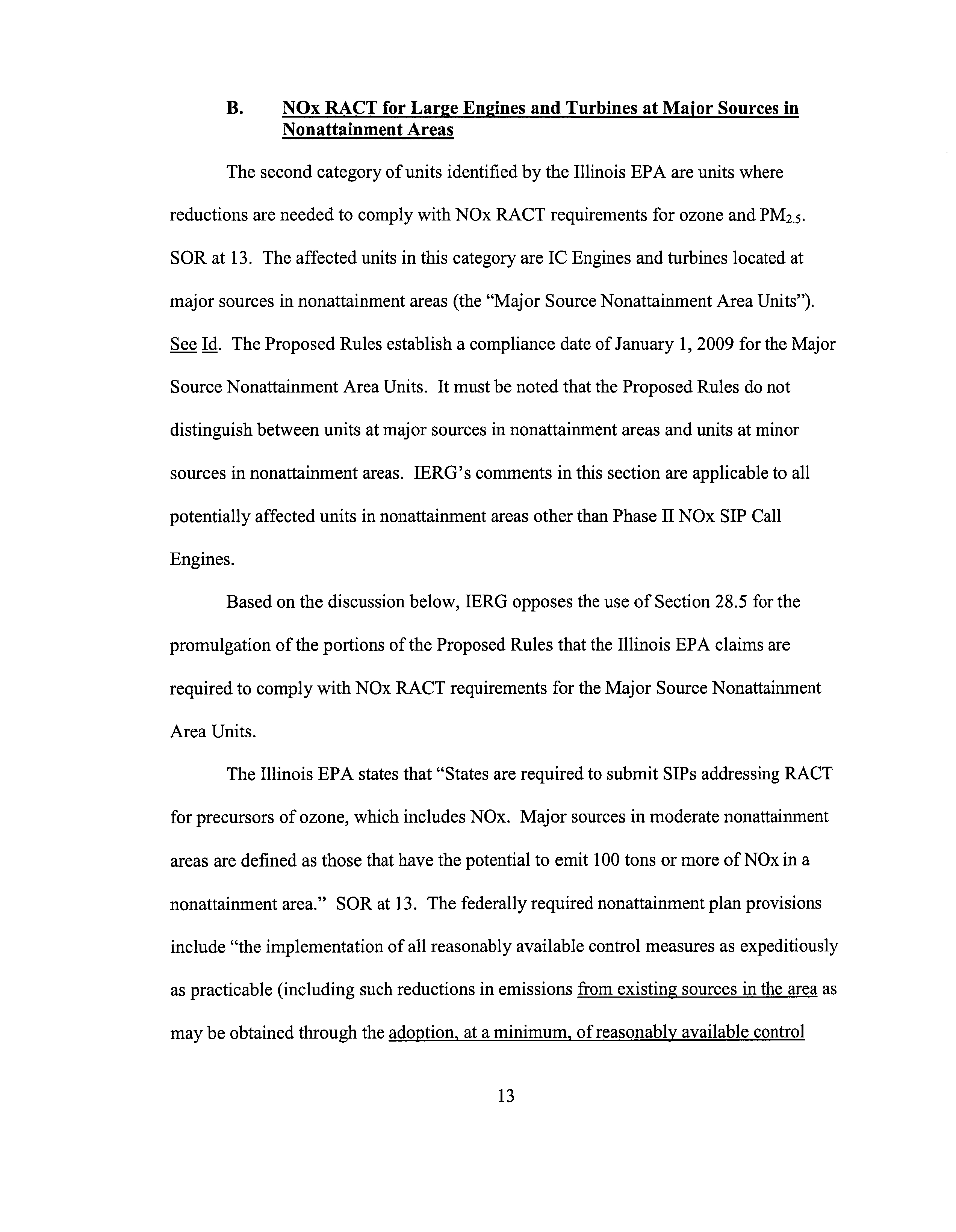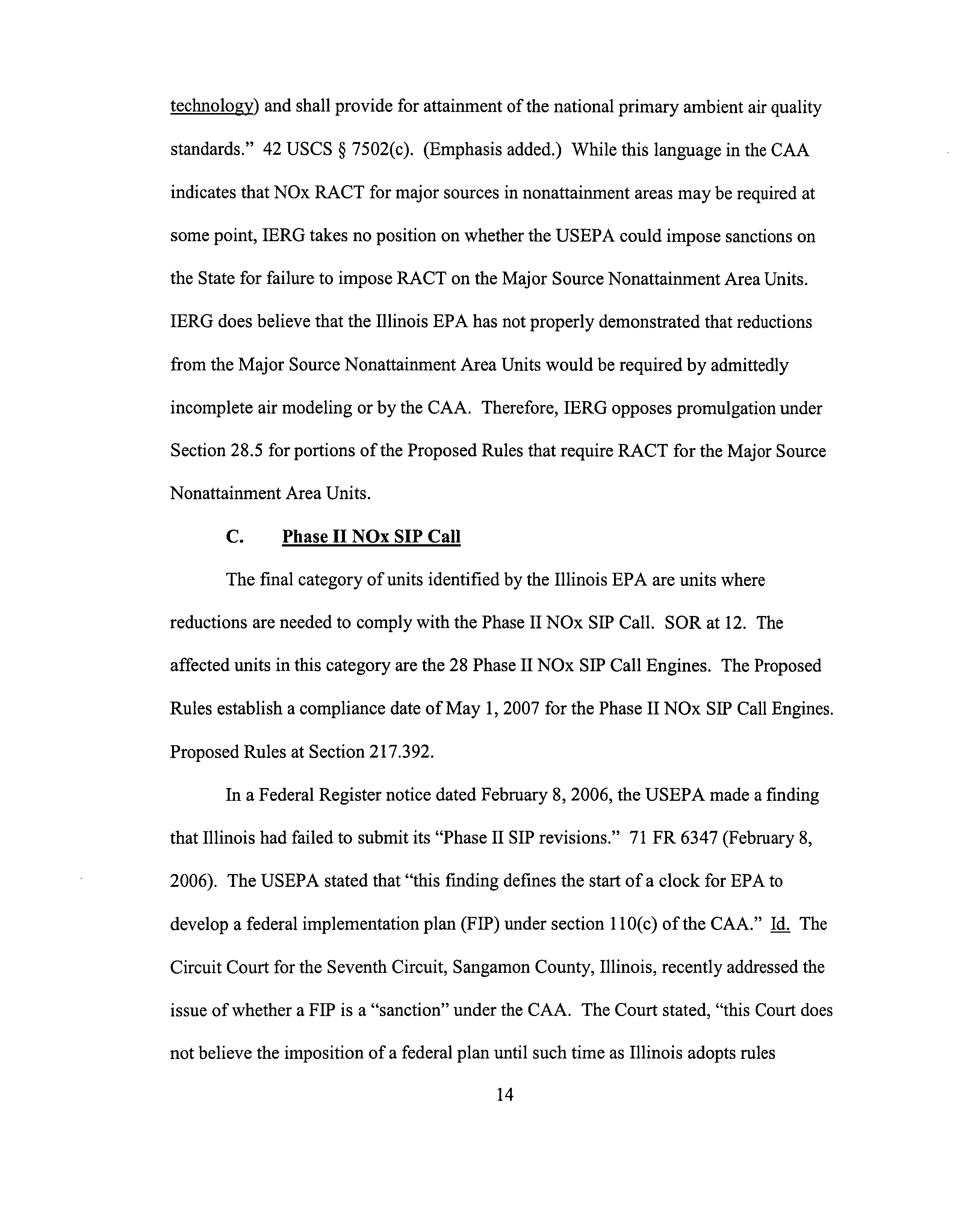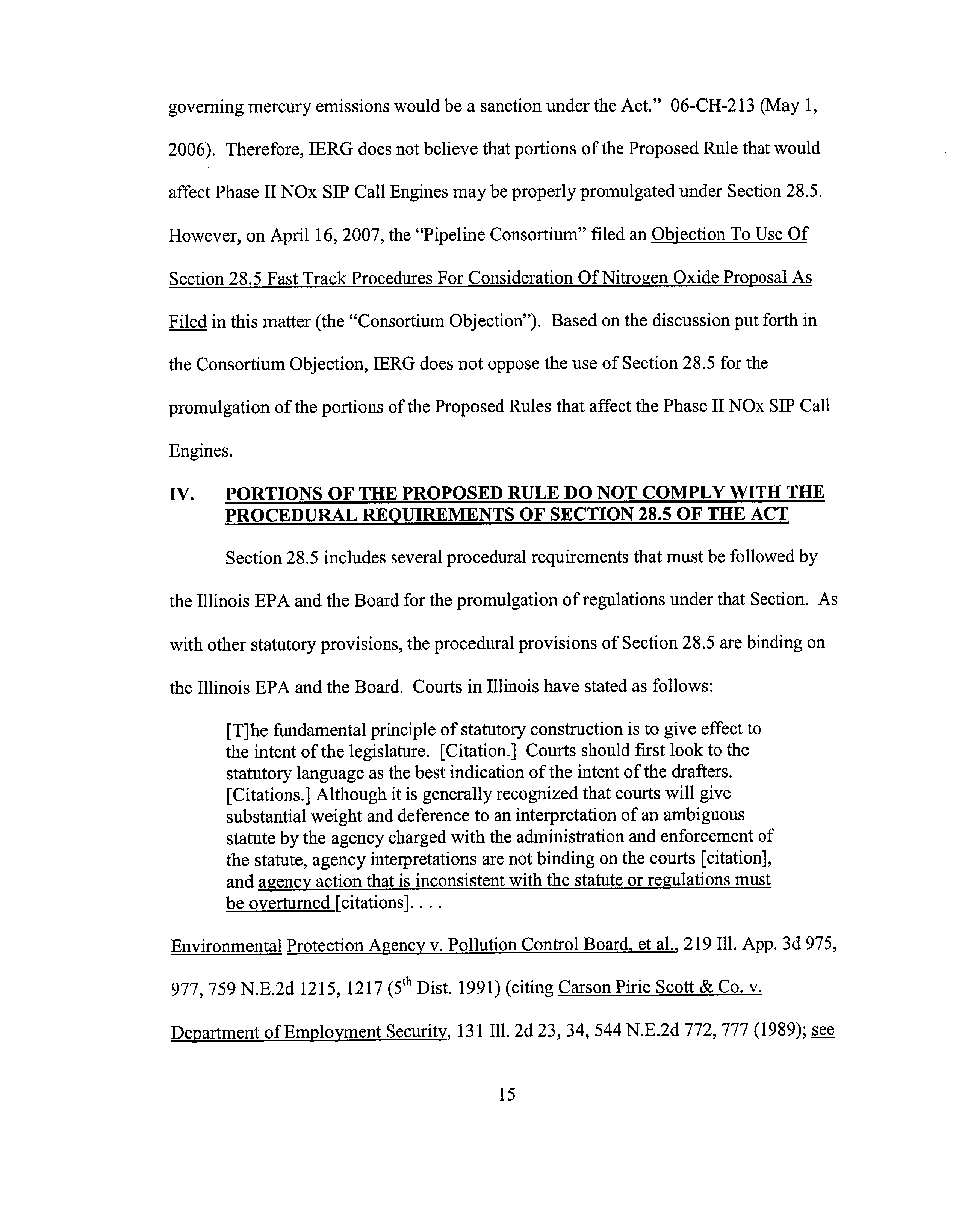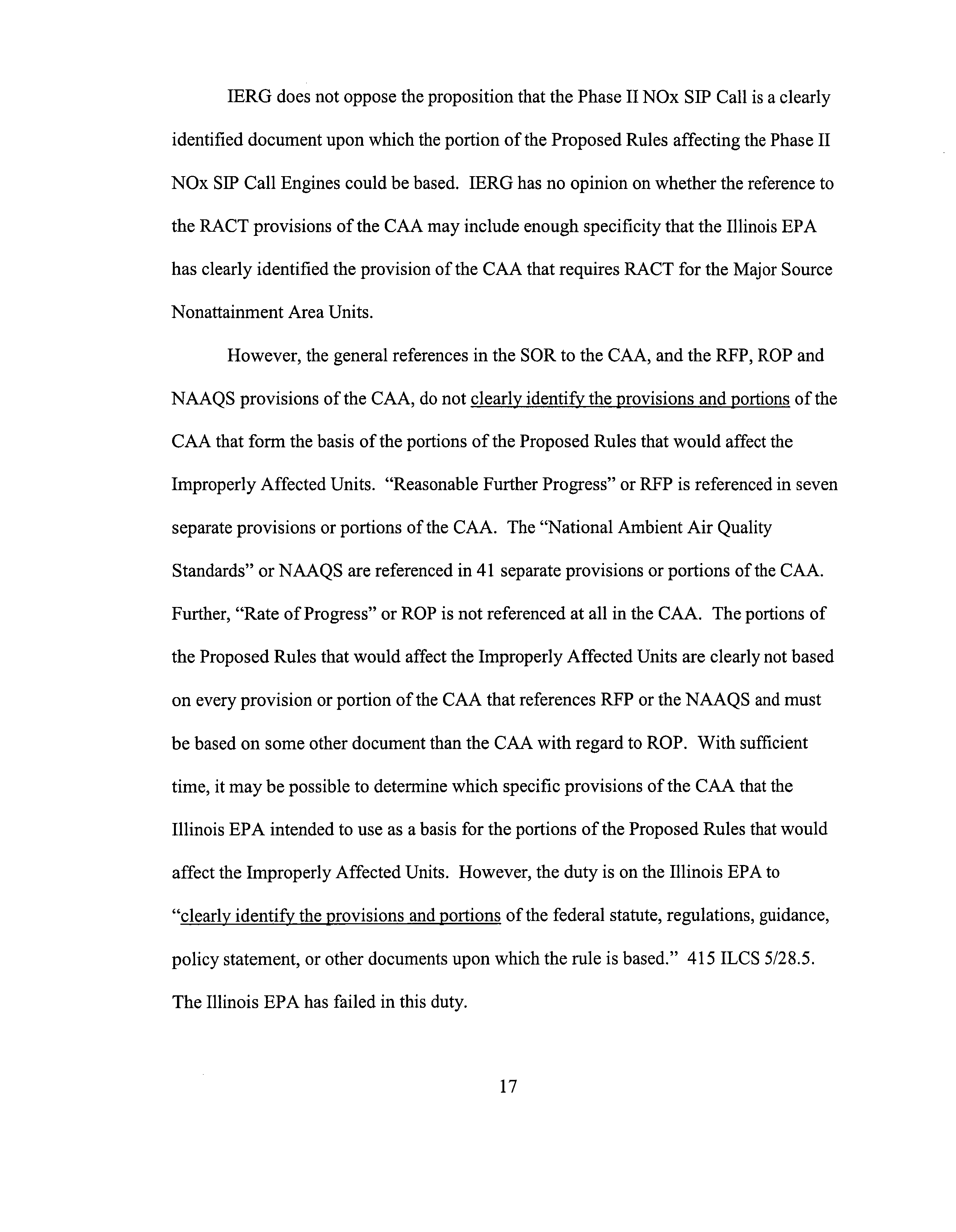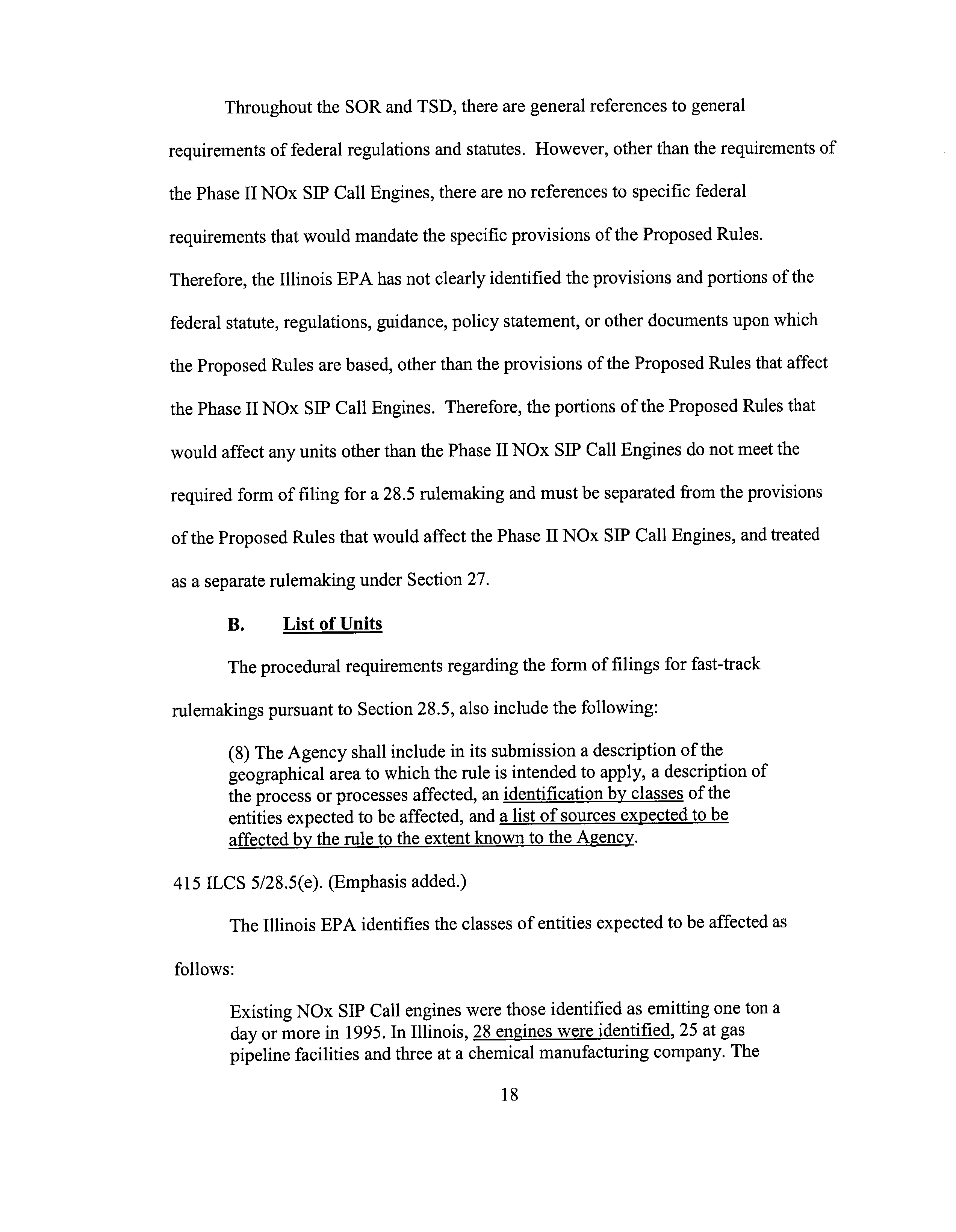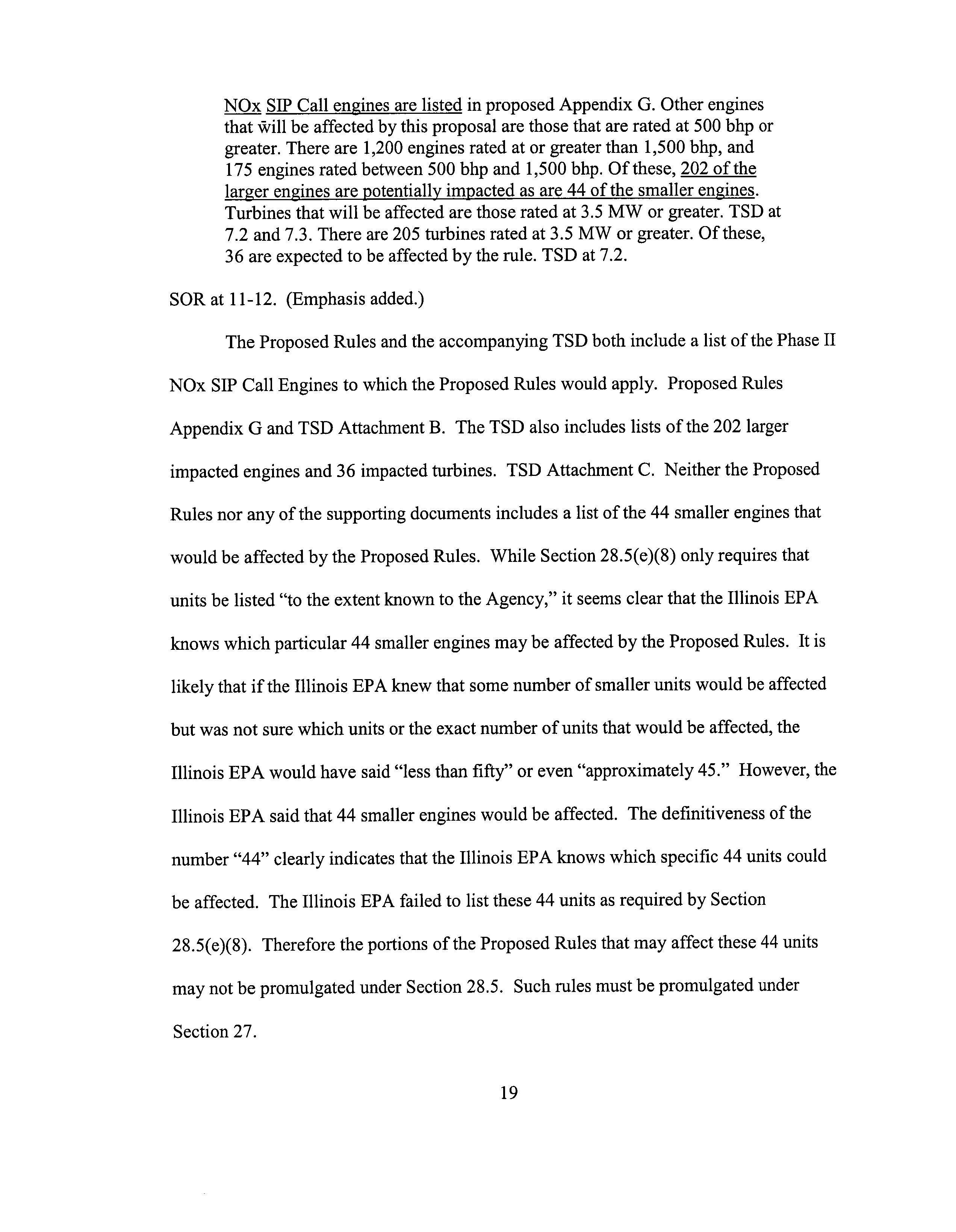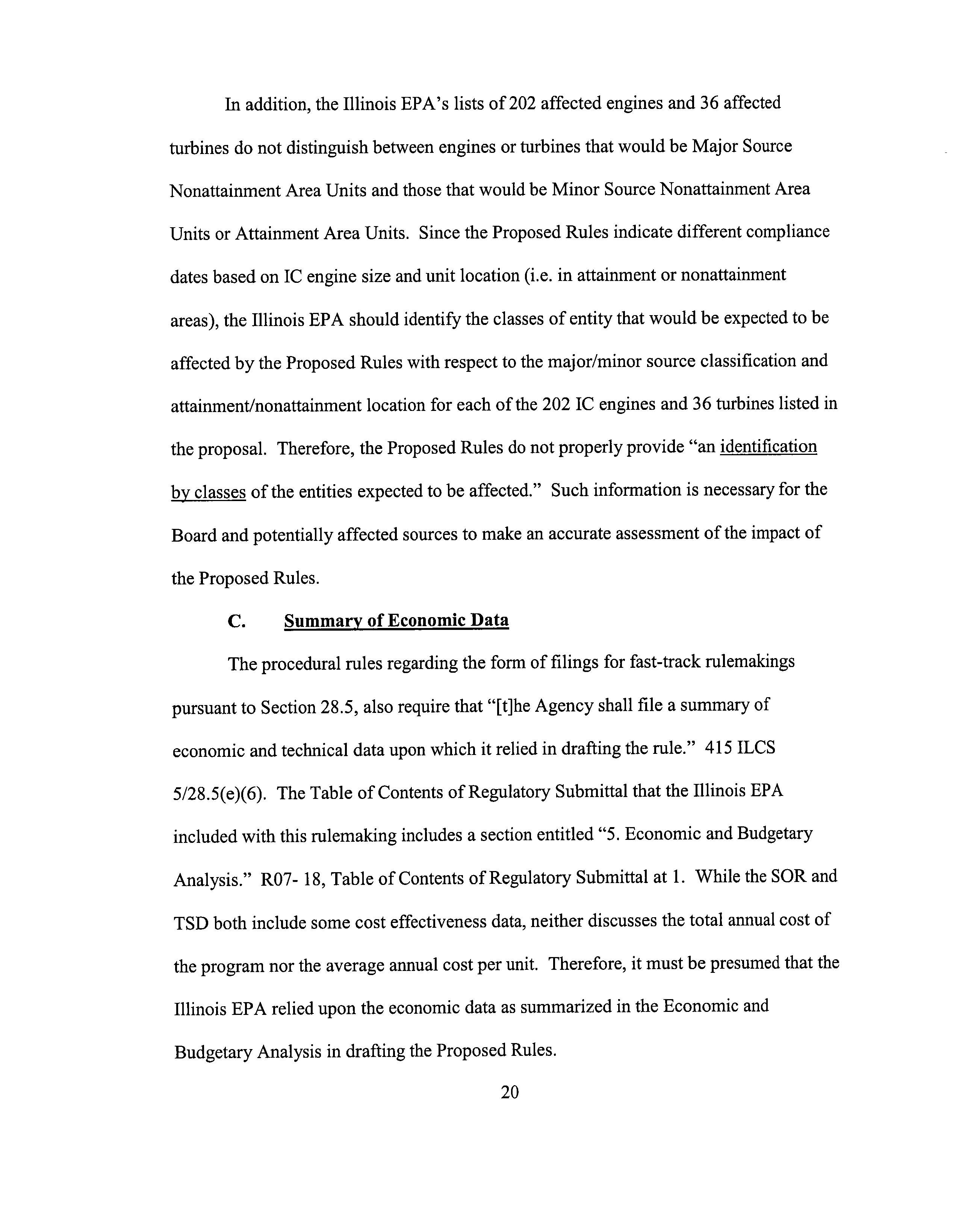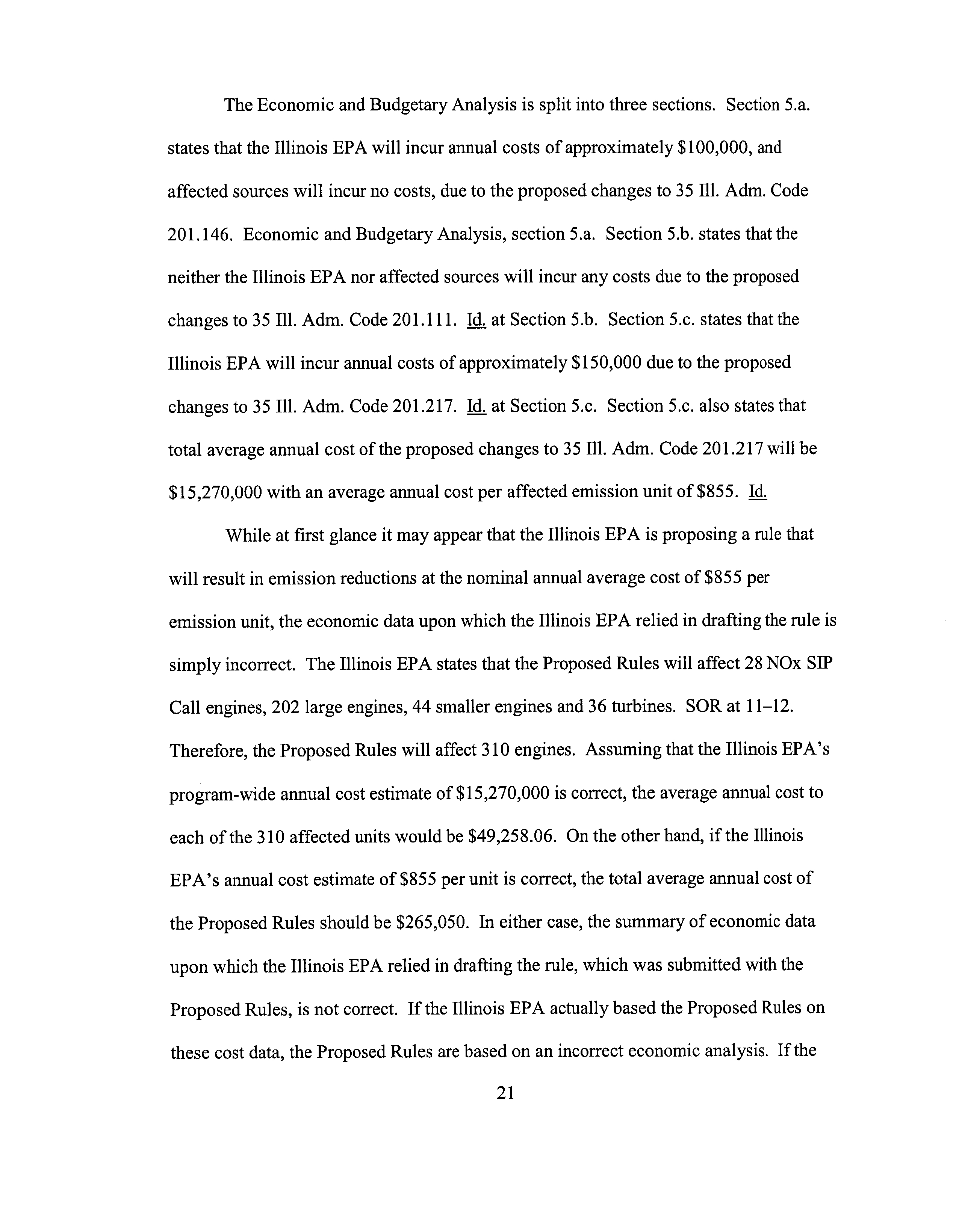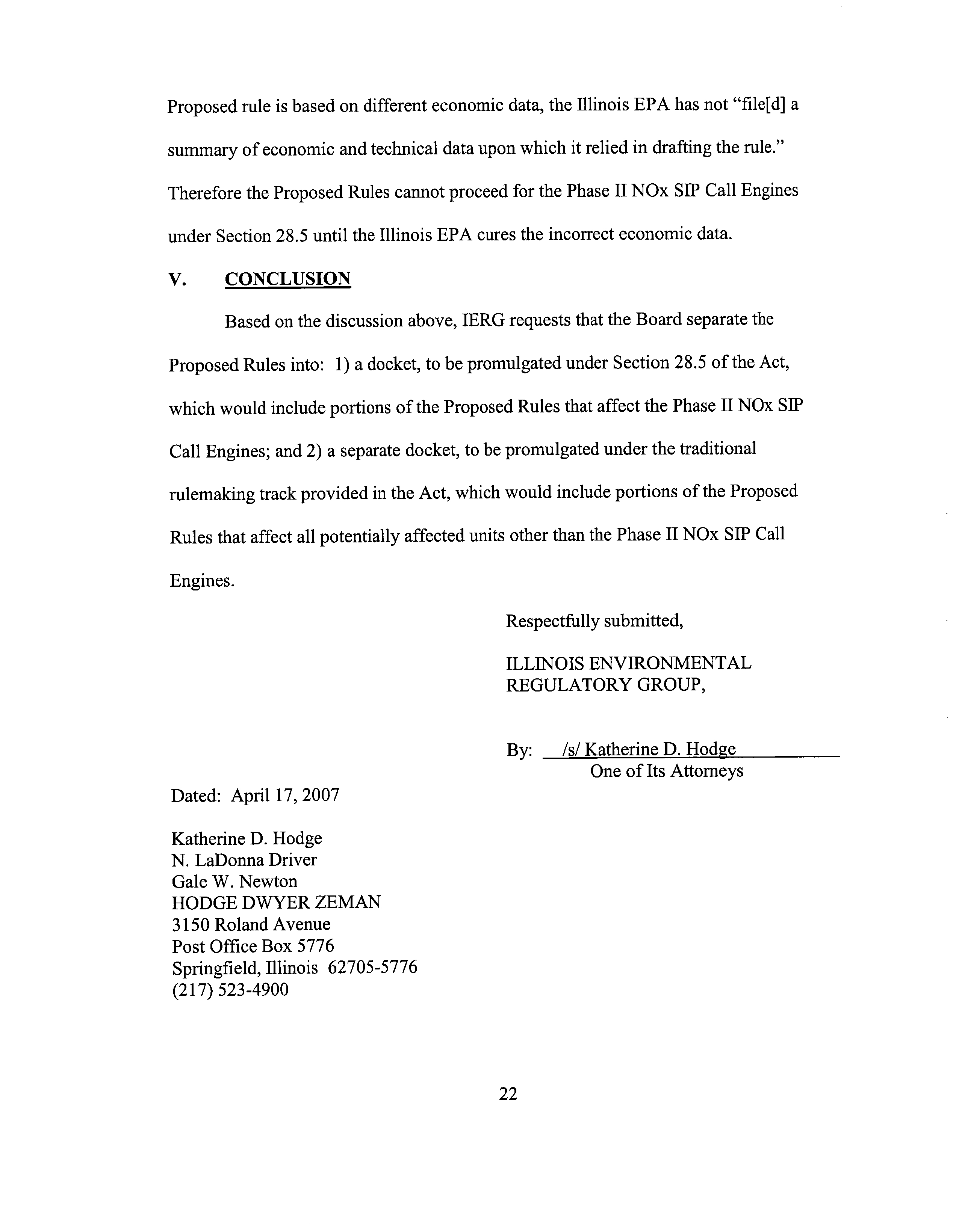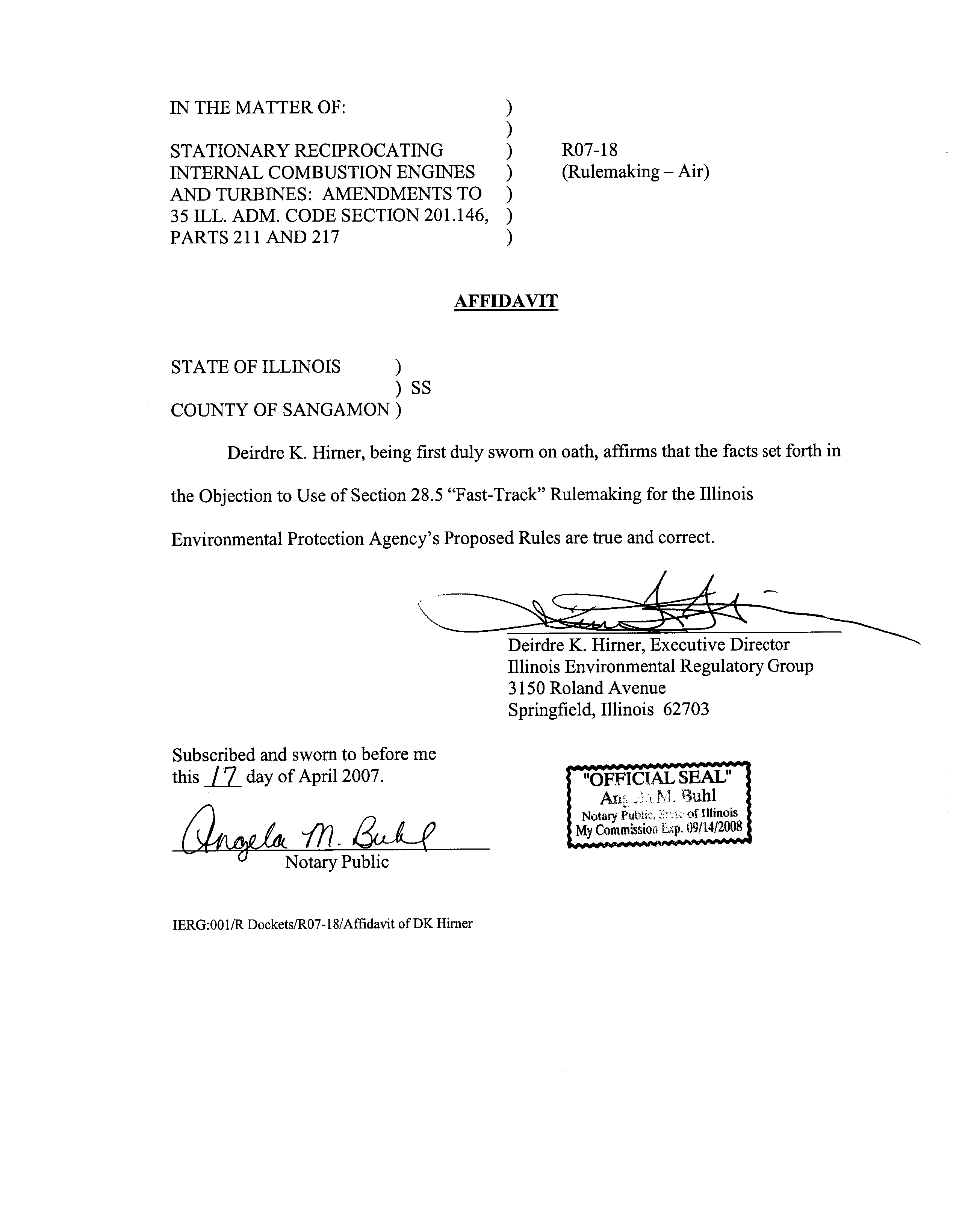BEFORE THE ILLINOIS POLLUTION
CONTROL BOARD
IN THE MATTER
OF:
)
STATIONARY RECIPROCATING
)
INTERNAL
COMBUSTION ENGINES )
AND TURBINES: AMENDMENTS
TO )
35 ILL. ADM. CODE SECTION 201.146,
)
PARTS 211 AND 217
)
R07-18
(Rulemaking - Air)
NOTICE OF FILING
TO: Ms. Dorothy M.
Gunn
Clerk of the Board
Illinois Pollution Control Board
100 West Randolph Street
Suite
11-500
Chicago, Illinois 60601
(VIA ELECTRONIC MAIL)
Tim Fox, Esq.
Illinois Pollution Control Board
James R. Thompson Center
100 West Randolph
Street
Suite 11-500
Chicago, Illinois 60601
(VIA FIRST CLASS MAIL)
(SEE PERSONS ON ATTACHED SERVICE LIST)
PLEASE TAKE NOTICE that I have today filed
with the Office of the Clerk of
the Illinois Pollution Control Board an OBJECTION TO USE OF
SECTION 28.5
"FAST-TRACK" RULEMAKING FOR THE ILLINOIS ENVIRONMENTAL
PROTECTION AGENCY'S PROPOSED RULES and AFFIDAVIT OF DEIRDRE
K. HIRNER, on behalf of the Illinois Environmental
Regulatory Group, copies of which
are herewith served upon you.
Respectfully
submitted,
Dated: April 17, 2007
Katherine D. Hodge
N. LaDonna Driver
Gale W. Newton
HODGE DWYER ZEMAN
3150 Roland Avenue
Post
Office
Box
5776
Springfield, Illinois 62705-5776
(217) 523-4900
ILLINOIS ENVIRONMENTAL
REGULATORY GROUP,
By:
/s/ Katherine D. Hodge
One of Its Attorneys
THIS FILING SUBMITTED ON RECYCLED PAPER
Electronic Filing, Received, Clerk's Office, April 17, 2007
CERTIFICATE OF SERVICE
I, Katherine D. Hodge, the undersigned, hereby certify that I have served the
attached OBJECTION TO USE OF SECTION 28.5 "FAST-TRACK"
RULEMAKING FOR THE ILLINOIS ENVIRONMENTAL PROTECTION
AGENCY'S PROPOSED RULES and AFFIDAVIT OF DEIRDRE K. HIRNER
upon:
Ms. Dorothy M. Gunn
Clerk of the Board
Illinois Pollution Control Board
100 West Randolph Street
Suite 11-500
Chicago, Illinois 60601
via electronic mail on April 17, 2007; and upon:
Tim Fox, Esq.
Illinois Pollution Control Board
James R. Thompson Center
100 West Randolph Street
Suite I1-500
Chicago, Illinois 60601
Rachel L. Doctors, Esq.
Assistant Counsel
Illinois Environmental Protection Agency
1021 North Grand Avenue East
Post Office Box 19276
Springfield,
Illinois
62794-9276
Renee Cipriano, Esq.
Elizabeth A. Leifel, Esq.
Sonnenschein Nath & Rosenthal
LLP
7800 Sears Tower
233 S. Wacker
Drive
Chicago, Illinois 60606-6404
Kathleen C. Bassi, Esq.
Schiff
Hardin, LLP
6600 Sears Tower
2 33 South Wacker Drive
Chicago, Illinois 60606-6473
Matthew Dunn, Esq.
Illinois Attorney General's Office
Environmental
Control
Division
James R. Thompson Center
100 West Randolph Street
Chicago, Illinois 60601
William
Richardson, Esq.
Chief Legal Counsel
Illinois Department of Natural Resources
One Natural Resources Way
Springfield,
Illinois
62702-1271
Electronic Filing, Received, Clerk's Office, April 17, 2007
by depositing said documents in the United States Mail, postage
prepaid, in Springfield,
Illinois, on April 17, 2007.
/s/ Katherine D. Hodge
Katherine
D. Hodge
IERG:001/R Dockets/R07-18/COS
- Objection
Electronic Filing, Received, Clerk's Office, April 17, 2007
BEFORE THE
ILLINOIS POLLUTION CONTROL BOARD
IN THE MATTER OF:
)
STATIONARY RECIPROCATING
)
INTERNAL
COMBUSTION
) R07-18
ENGINES AND TURBINES:
)
(Rulemaking
- Air)
AMENDMENTS TO 35 ILL.
)
ADM. CODE SECTION 201.146,
)
AND PARTS 211 AND 217
)
OBJECTION TO USE OF SECTION 28.5 "FAST-TRACK"
RULEMAKING FOR THE ILLINOIS ENVIRONMENTAL
PROTECTION AGENCY'S PROPOSED RULES
NOW COMES the Illinois Environmental Regulatory Group ("IERG"), by and
through its attorneys,
HODGE DWYER ZEMAN,
and submits its Objection due to the
Illinois Environmental Protection Agency's (the "Illinois EPA") improper use of Section
28.5 of the Illinois Environmental
Protection Act
(the "Act") in the Stationary
Reciprocating Internal Combustion Engines and Turbines Proposal (the "Proposed
Rules").
IERG is an affiliate of the Illinois State Chamber of Commerce, and is a not-for-
profit Illinois corporation comprised of 54 member companies engaged in power
generation, industry, commerce, manufacturing, agriculture, trade, and transportation,
which are regulated by governmental agencies that promulgate, administer or enforce
environmental
laws, regulations, rules or policies. IERG's member companies therefore
have a significant stake
in how
environmental
requirements are
established. And, a
number of
IERG member companies own and operate emission units that are potentially
affected by the Proposed Rules.
As set
forth in detail below, IERG does not believe that the Proposed Rules are
appropriate for a Section 28.5 "fast-track" rulemaking proceeding. However, based on
Electronic Filing, Received, Clerk's Office, April 17, 2007
the Consortium Objection' (as defined below), IERG does not object to the use of Section
28.5 rulemaking for the 28 internal combustion engines ("IC engines") that are affected
by the NOx State Implementation
Plan
Call
Phase II (the
"Phase
II
NOx SIP Call
Engines"). All other requirements in the Proposed Rules that would affect units other
than the Phase II NOx SIP Call Engines are non-required rules, and must be considered
under a second
docket that should proceed under Title VII of the Act.
I. INTRODUCTION
On April 2, 2007, the Illinois EPA announced that it "has filed a proposal with the
Illinois Pollution Control Board for regulatory
proceedings for the control of
NOx
emissions from stationary
reciprocating internal combustion engines (RICE) and
turbines." http://www.epa.state.il.us/air/ (April 3, 2007).
Regulatory proposal R07-18
was date stamped as received by Illinois Pollution Control Board (the "Board") on
April 6, 2007, and posted to the
Board's
website
on that date. The Illinois EPA contends
that the:
proposal is intended to satisfy Illinois' obligations under the United States
Environmental Protection
Agency's ("USEPA") NOx State
Implementation
Plan ("SIP") Call Phase II. The proposed new Subpart is
also intended to address, in part, Illinois' obligation to meet certain
requirements under the federal Clean Air Act (the "CAA")
(which also
incorporates the amendments
(CAAA) as per Section 28.5(a) of the Act),
42 U.S.C. § 7401, et seq.,
specifically the requirements for reasonable
further progress ("RFP"),
reasonably available control technology
("RACT"),
rate-of-progress ("ROP"), and attainment demonstrations
for
the
8-hour ozone and PM2.5 National Ambient
Air Quality
Standards
("NAAQS").
R07-18, Statement
of Reasons ("SOR") at 1-2.
1 See R07-18 Objection To Use Of
Section 28.5 Fast Track Procedures For Consideration Of Nitrogen
Oxide
Proposal As Filed (April 16, 2007).
2
Electronic Filing, Received, Clerk's Office, April 17, 2007
The Illinois EPA submitted the Proposed Rules to
the
Board
pursuant to Sections
9.9, 10, 27 and 28.5 of the Act. SOR at 1. The Illinois EPA proposed that the Board treat
the Proposed Rules
as a
fast-track rulemaking pursuant
to Section 28.5, which allows for
the expedited review of regulations that are "proposed by the Agency and required to be
adopted by the State under the Clean Air Act as amended by the Clean Air Act
Amendments of 1990 (CAAA)." 415 ILCS 5/28.5(a). However, only rules required to
be adopted by the
State
under the Clean Air Act ("CAA") can be fast-tracked under
Section 28.5 of the Act.
IERG opposes the Illinois EPA's use of Section 28.5 of the Act for the proposed
regulation of emission units other than the Phase II NOx SIP Call Engines. IERG urges
the
Board
to create
a
second
docket for the portions of the Proposed Rules that
would
affect all other emission units and to proceed under Title VII of the Act in that
proceeding.
II. THE PROPOSED RULE MUST BE SPLIT INTO PORTIONS THAT MAY
BE PROMULGATED UNDER SECTION 28.5 OF THE ACT AND
PORTIONS THAT MAY NOT BE PROMULGATED UNDER SECTION
28.5 OF THE ACT
As described below, the Proposed Rules are not required by the CAA. However,
based on the Consortium's
Objections, IERG does not object to the portions of the
Proposed Rules that affect the Phase II NOx SIP Call Engines. See R07-18 Objection To
Use Of Section 28.5 Fast
Track Procedures For Consideration Of Nitrogen Oxide
Proposal As Filed (April
16, 2007). Therefore, the Proposed Rules should be separated
pursuant to Section 28.50). Section 28.50) provides:
Electronic Filing, Received, Clerk's Office, April 17, 2007
The Board shall adopt rules in the fast-track rulemaking docket under the
requirements of this Section that the CAAA requires to be adopted, and
may consider a non-required rule in a second docket that shall proceed
under Title VII of this Act.
415 ILCS 5/28.50).
The Illinois General Assembly, through consultation with the Illinois EPA, the
public,
and the regulated community, chose to limit fast-track proceedings to rules
required to be adopted by the CAA where sanctions can be imposed for failure to adopt
such rules.
415 ILCS 5/28.5. This is not a limitation that should be ignored, as the
Illinois EPA seemingly does in its Proposed Rules. Without such a limitation, the Act
would allow any
proposed regulations related to the CAA to be fast-tracked, thus
bypassing the deliberative proceedings of
a regular rulemaking. IERG
participated
in the
development
of this section of the Act and has always maintained the position that this
limitation is necessary.Z Otherwise, all CAA
regulations
would be subject
to the fast-
track timeframe,
providing less meaningful opportunities for public comment on the
proposed regulations.
IERG has also advocated the proper use of accelerated rulemaking procedures in
other
air rulemaking proceedings. In In the Matter of. RACT Deficiencies
-
Amendments to 35 Ill. Adm. Code
Parts 211 and 215, R89-16 (Feb. 8, 1990), the Illinois
EPA
sought to amend Parts 211 and 215 of the Board's air regulations under the
federally
required rules procedures of Section
28.2. The Board severed the rulemaking into two
dockets
because it concluded that sections of the proposed
rulemaking were not federally
required. The Board placed the non-federally
required provisions in subdocket B "to
address these proposed
amendments under Section 28 of the Act."
Id. at 1. The Board
2 Please see attached Affidavit of
Deirdre K. Hirner.
4
Electronic Filing, Received, Clerk's Office, April 17, 2007
explained that it was "persuaded by the thorough analysis" of the Industry Group and by
the "lack of analysis in the Agency's response" when it found that portions of the
proposed regulations were
not "required." Id. at 8.
Although the RACT Deficiencies rulemaking was not filed pursuant to Section
28.5, but rather pursuant
to the federally required rules procedures of Section 28.2, the
Board must be careful of its statutory rulemaking authority in this proceeding, as it
clearly was
in the RACT Deficiencies proceeding. It is certainly the Illinois EPA's
responsibility to propose regulations consistent with statutory requirements. Yet, as
discussed
herein, the Proposed Rules simply do not meet the statutory parameters for a
Section 28.5 fast-track rulemaking. The Board must so find and ensure that any action to
promulgate the Proposed
Rules
does
not occur outside the Board's rulemaking authority.
In a recent rulemaking, the Board was asked to split a proposed
rule into
portions
that were required by
the CAA and portions that were not so required. See Board R06-
25. (Wherein IERG joined in Utility Motions And Objections To The Use Of Section
28.5 of the Act for the Illinois EPA's Mercury
Proposal.) R06-25, Illinois Environmental
Regulatory Group's Response In Support of Utility Motions And Objection
To The
Illinois Environmental
Protection Agency's Use Of Section 28.5 Of The Illinois
Environmental Protection Act For Consideration Of Its
Mercury Proposal (March 29,
2006). In refusing to split the rulemaking,
the Board stated "the approach taken by the
Agency to meet the
federal mandate is not conducive to identifying and `separating out'
portions of the proposal for consideration
under Section 27. As such, the Board will
proceed under the fast-track procedures, rather than risk failing to adopt the
required
portions of the proposal by November
17, 2006, in order to avoid potential sanctions."
5
Electronic Filing, Received, Clerk's Office, April 17, 2007
Id.,
Order of
April 20, 2006 at 18. However, the
Circuit
Court of the
Seventh Judicial
District in Sangamon County halted the entire proceeding under Section 28.5 because the
Court found that the "fast-track" rulemaking in that matter would deprive the Plaintiffs of
a fair hearing. In the matter at hand, such a "separating out" process is not difficult. The
28 Phase II NOx SIP Call Engines
are
clearly
identified in the proposal and the Proposed
Rules.
The Proposed Rules could be separated into two dockets. The first docket would
be applicable only to the 28 listed Phase
II
NOx SIP Call
Engines and could proceed
under Section
28.5
without
the delay that could be caused by judicial review. The second
docket would be applicable to the other
potentially affected units and could proceed
under the traditional rulemaking procedures provided in the Act.
III. PORTIONS OF THE PROPOSED RULE
DO
NOT
COMPLY
WITH
THE
APPLICABILITY REQUIREMENTS OF SECTION
28.5 OF THE ACT
The Act limits the applicability of 28.5 to certain types of rulemakings. The types
of rulemakings that may be performed pursuant
to Section 28.5, are as follow:
(a) This Section shall apply solely to the adoption of
rules
proposed
by
the Agency and required to be adopted by
the
State
under the
Clean Air Act as amended by
the
Clean
Air Act Amendments of
1990 (CAAA).
(c)
***
For purposes of this Section,
a `fast-track' rulemaking proceeding
is a proceeding
to promulgate a rule that the CAAA requires to be
adopted.
For purposes of this Section, `requires to be adopted'
refers only to those regulations or parts of regulations
for which
the United States Environmental
Protection Agency is empowered
to impose sanctions
against a State for failure to adopt such
rules...
415
ILCS 5/28.5.
According
to the Illinois EPA, the Proposed Rules are intended to perform
three
primary regulatory functions and therefore
affect three types of emission units. See SOR
6
Electronic Filing, Received, Clerk's Office, April 17, 2007
at 12-13. The United States Environmental Protection Agency ("USEPA") is not
currently empowered to impose sanctions against the State for failure to adopt rules to
meet such requirements. Each category will be discussed separately below.
A. Attainment of the 8-hour and PM2.5 NAAOS
The first category of units identified by the Illinois EPA are units where emission
"reductions [are]
needed for attainment of the [8-hour ozone and PM2.5 ] NAAQS." Id. at
12. The affected units in this category would appear to include IC engines over 500 bhp
and certain turbines at minor sources in nonattainment areas and at all sources in
attainment areas statewide (the "Improperly Affected Units").3 The Proposed Rules
establish compliance
dates of: 1) January 1, 2009 for IC engines and turbines located at
major sources in nonattainment areas; 2) January 1, 2011 for larger IC engines or turbines
located
in
attainment
areas; and 3) January 1, 2012 for smaller IC engines or turbines
located in attainment areas. Proposed Rules at Section 217.392.
Based on the discussion below,
the specific portions of the Proposed Rules that
would affect the Improperly Affected Units: 1) are
not required
by the CAA;
2) could
not trigger sanctions
if not approved; and 3) are, in any case, not ripe for promulgation
under Section 28.5 because the rules are based on
preliminary modeling and have been
drafted without the benefit of finalized guidance
from the USEPA. Therefore, the
portions of
the Proposed Rules that would require reductions from the
Improperly
Affected Units must be
separated from the portion of the Proposed Rules that would
affect the
Phase II NOx SIP Call Engines, and be treated under
a
separate
rulemaking as
described above.
3 This category also presumably
includes reductions expected from NOx RACT for
IC
engines
and turbines
located at major sources in nonattainment areas
(discussed in more detail in Section B below).
7
Electronic Filing, Received, Clerk's Office, April 17, 2007
The SOR repeatedly notes the general
duty of the Illinois EPA to provide
attainment demonstrations, and to eventually include such demonstrations in
the State's
SIP. The attainment demonstrations discussed by the Illinois EPA
are apparently
required by Sections 172 and 182 of the CAA (42 USCS § 7502 and 42 USCS
§ 7511(a), respectively). Both Sections 172 and 182 include
extensive discussions of the
items that must be included in attainment demonstrations. Both Sections
discuss specific
requirements for major sources
within
the nonattainment
area, such as RACT and review
of new sources. See Id. However, neither Section requires any specific action with
regard to any sources and/or emissions outside a nonattainment area.
See Id.
As provided above, the Board has authority under Section 28.5 only to fast-track
rules
that are
required to be adopted by the
State
under the
CAA. 415 ILCS 5/28.5(a).
(Emphasis added.) Further, the phrase "`requires to be adopted' refers only to those
regulations or parts of regulations for which the United States Environmental Protection
Agency is empowered to impose sanctions against a State for failure to adopt such
rules . . . ." 415 ILCS 5/28.5(c).
The
USEPA
may enforce sanctions including
the
loss
of highway funds or increased offsets under Section 179 [42 USCS § 7509] when: 1) a
state
has failed to submit a plan that satisfies the minimum criteria; 2) USEPA
disapproves a plan; 3) a state fails to provide other required submissions; or (4) USEPA
determines that a state is not implementing
its
plan. See
42
USCS § 7509.
With regard to requiring statewide emission controls on the Improperly Affected
Units, there are no minimum criteria
listed in the
CAA
that include such requirements.
Further, there has been no approval or disapproval of any attainment plan. In addition,
any potential requirement of
further submissions is years in the future. In short, the
8
Electronic Filing, Received, Clerk's Office, April 17, 2007
statewide applicability of the Proposed Rules to the
Improperly Affected
Units
is not
required by
the
CAA,
and the USEPA could not enforce any sanction against the State if
Illinois did not adopt a statewide rule affecting the
Improperly Affected Units.
Therefore, Section 28.5
is unavailable for the portions of the Proposed Rules that would
apply to the Improperly Affected Units.
The
Illinois EPA implies that all of the Proposed Rules must be implemented
almost immediately or sanctions may be
imposed. The Illinois EPA states that
"Moderate
nonattainment areas are required to submit attainment demonstrations by June
15, 2007, addressing how the State will achieve
the 8-hour ozone standard by the
attainment
date of June 15, 2009 . . ." SOR at 5. The Illinois
EPA
claims
that "Section
110 of the CAA requires that measures included
in all State Implementation Plans
("SIP") and SIP
revisions be fully adopted. The attainment demonstrations for ozone
and
PM2.5 will revise Illinois' SIP." Id. at 3. However,
"EPA rulemaking to incorporate a
State regulation
in a SIP may also be initiated when a rule has been
proposed by the State
but not yet adopted." 47 FR
27073 (June 23, 1982). This interpretation was most
recently reiterated by
the USEPA with regard to the Phase II NOx SIP
Call. There, the
USEPA
stated, "[w]e note that States can
submit draft plans (i.e., plans that have not
completed the final steps
in the State administrative process) for
parallel processing." 69
FR 21604, 21633. Based on longstanding
USEPA guidance, it is clear that the USEPA
would not seek sanctions
against the State for failure to adopt the portions
of the
Proposed Rules affecting
the Improperly Affected Units
so long as such portions of the
Proposed Rules have been
proposed. Here, such rules have been
proposed.
Electronic Filing, Received, Clerk's Office, April 17, 2007
Furthermore, as noted by the Illinois EPA, the air modeling effort upon which the
Illinois EPA is basing the portions of this rulemaking that would apply to the Improperly
Affected Units
has not
been
completed. SOR at 12. The submittal for the Proposed
Rules includes
two documents that may discuss air modeling with respect to the required
reductions for attainment. These documents are: 1) Technical Support Document for
Final Clean
Air Interstate Rule, Air Quality Modeling, U.S. EPA, Research Triangle
Park, NC, March 2005, and
2) LADCO, Attainment Strategy Options, Draft, October 28,
2005. See R07-18, Table of Contents of Regulatory Submittal. It must be noted that the
Technical Support Document for the CAIR rule is, at best, only peripherally
related to the
matters addressed by the Proposed Rules. In addition, the LADCO document is clearly
marked as a draft document and
it is nearly 18 months old. Attachment A of the
Technical Support Document ("TSD") entitled Assessment of Regional NOx Emissions
in the Upper Midwest, LADCO, February 15,
2007
(the
"TSD Attachment"), includes
additional modeling
information. However, the TSD Attachment apparently does not
model the impact of the Proposed
Rules. The TSD Attachment does state that: 1) with
regard to NOx
in relation to the 8 hr ozone standard, "[t]he source region results show that
nearby emissions generally have the
highest impacts;" TSD at 67; and 2) with regard to
NOx in relation to PM2.5, "[t]he source
region results show that emissions from nearby/local
sources are large contributors to
PM2.5 concentrations. There is also a sizable regional
contribution;"
TSD at 72. The TSD Attachment
does not appear to provide support for the
Illinois
EPA's apparent position that immediate statewide
emission reductions from the
Improperly
Affected Units are required by air modeling
and therefore, somehow required by
the CAA.
10
Electronic Filing, Received, Clerk's Office, April 17, 2007
Moreover, the USEPA guidance for implementing the PMz.5
NAAQS has yet to
be finalized. SOR at 13. It is difficult to understand how a rule may be "required to be
adopted" by the
CAA,
for purposes of Section 28.5, when: 1) modeling
to determine
whether such a rule would be needed or effective has yet to be completed, 2) the most
recent modeling information does not specifically address the emission reductions
claimed for the Proposed Rules, and 3) the USEPA itself has yet to provide guidance on
how
such a
rule should be structured.
It must also be considered that the Illinois EPA relies on two Board rulemakings
for the proposition that the "Board has the authority to adopt regulations to avoid
sanctions for a failure to meet the requirements of Section 172 of the CAA as it is also
contained in Part D of the CAA." SOR
at 11. The Board rulemakings are: In the Matter
of: 15% ROP Plan Control Measures for VOM Emissions-Part II Marine Vessel
Loading: Amendments 35111. Adm. Code Parts 211, 218 and 219, R94-15, October 25,
1994; and In the Matter of: Visible and Particulate
Matter Emissions-Conditional
Approval
and
Clean
Up Amendments to 35111. Adm. Code Parts 211 and 212, R96-5,
May 22, 1996. Id. The R94-15 rulemaking involved Sections
218
and
219
and,
therefore, by definition
was not applicable statewide. With regard to the R96-5
rulemaking, the Board stated "[a]lthough this proposal
includes amendments
which
will
apply statewide, the
major changes in this proposal will affect steel production sources
located in the McCook and Lake Calumet areas in Cook County and the Granite City
area
in Madison County." R96-5,
Adopted Rule, Final Notice, May 16, 1996. Therefore, the
authority cited by the Illinois EPA does not
apply to statewide rulemaking affecting units
such as the Improperly
Affected Units.
11
Electronic Filing, Received, Clerk's Office, April 17, 2007
Finally, in the past, the Board has applied RACT rules
(similar to the statewide
portions of the Proposed Rules) to areas outside of nonattainment areas. See, for example
R86-36, In the Matter of: Proposed Amendments to
35
Ill.
Adm. Code 215.204, 215.211,
and 215.212: Heavy Off-Highway Vehicle Products, June 25, 1987. However, in that
matter the Board stated:
It is required, at a minimum, that RACT rules be applied within counties
which are nonattainment for ozone. However, there are compelling
reasons that the rules also apply
in some
counties
in addition
to those
which are classified as
nonattainment. The Board believes that the most
important of these is that emissions in certain attainment counties can
impact on the ozone air quality in adjacent nonattainment counties via the
phenomenon of transport. The significance of the transport phenomenon
has been extensively developed in the instant record ....
Id. at 37. (Emphasis added.) See also R80-5, In The Matter Of: RACT II Rules, Chapter
2: Air Pollution, May 27, 1982
(extending rule
beyond the
nonattainment
area where
"[t]here is strong logic and evidence in the record of this proceeding of hydrocarbon
transport, of significant ozone
levels
occurring
throughout the state and
of violations of
the standard continuing to occur in several areas.").
In the
matter
at
hand, there has been no "extensive" development of the potential
for the
transport of NOx from Attainment Area Units into nonattainment areas. The
record here has not been developed sufficiently to demonstrate that statewide
reductions
from the
Improperly Affected Units will have any affect on nonattainment areas. The
Proposed Rules and accompanying documents merely make the
assumption.
For the reasons described in this section, the Board must separate the portions of
the Proposed Rules that would require reductions from the
Improperly Affected
Units
and
the units described
in the following section from the remainder of the Proposed Rules and
treat such portions of the Proposed Rules under a separate
rulemaking.
12
Electronic Filing, Received, Clerk's Office, April 17, 2007
B. NOx RACT for Large Engines and Turbines at Major Sources in
Nonattainment Areas
The second category of units identified by the Illinois EPA are units where
reductions are needed to comply with NOx RACT requirements for ozone and PM2.5.
SOR at 13. The affected units in this category are IC Engines and turbines located at
major
sources
in nonattainment areas (the "Major
Source
Nonattainment Area
Units").
See Id. The Proposed Rules establish a compliance date of January 1, 2009 for the Major
Source Nonattainment Area Units. It must be noted that the Proposed Rules do not
distinguish between units at major sources
in nonattainment
areas and units at minor
sources in nonattainment
areas. IERG's comments in this section are applicable to all
potentially affected units in nonattainment areas other than Phase II NOx SIP Call
Engines.
Based on the discussion below,
IERG
opposes the use of Section 28.5
for
the
promulgation of the portions of the Proposed Rules that the Illinois EPA claims are
required to comply with NOx RACT requirements for the Major Source Nonattainment
Area Units.
The Illinois EPA states that "States are required to submit SIPs addressing
RACT
for precursors of ozone, which includes NOx. Major sources in moderate nonattainment
areas are defined as those that have the potential to emit
100 tons
or
more of NOx in a
nonattainment area." SOR at 13.
The federally required nonattainment plan provisions
include "the implementation of all reasonably available control
measures as
expeditiously
as practicable (including
such reductions in emissions from existing sources in the area as
may be obtained through the adoption, at a minimum, of
reasonably available control
13
Electronic Filing, Received, Clerk's Office, April 17, 2007
technology) and shall provide for attainment of the national primary
ambient air quality
standards." 42 USCS § 7502(c). (Emphasis
added.) While this language in the CAA
indicates that NOx RACT for major sources in nonattainment areas may
be required at
some point, IERG takes no
position on whether the USEPA could impose sanctions on
the State for failure to impose RACT on the Major Source Nonattainment Area
Units.
IERG
does
believe that the Illinois EPA
has not properly demonstrated that reductions
from the Major Source Nonattainment Area Units would be required by admittedly
incomplete air modeling or by the CAA. Therefore, IERG opposes promulgation under
Section 28.5 for portions of the Proposed Rules that require RACT for the Major Source
Nonattainment Area Units.
C. Phase II NOx SIP Call
The final category of units identified by the Illinois EPA
are units where
reductions are needed to comply with the Phase II NOx SIP Call. SOR at 12. The
affected units in this category are the 28 Phase II NOx SIP Call Engines. The Proposed
Rules establish a compliance date of May 1, 2007 for the Phase II NOx SIP Call Engines.
Proposed Rules at Section
217.392.
In a Federal Register notice dated February 8, 2006, the USEPA made a finding
that Illinois had
failed to submit its "Phase II SIP revisions."
71
FR
6347 (February 8,
2006). The USEPA stated that "this finding defines the start of a clock for EPA to
develop a federal implementation
plan (FIP) under
section
110(c)
of the CAA."
Id. The
Circuit Court for the Seventh Circuit, Sangamon County, Illinois, recently addressed the
issue of whether
a FIP is a "sanction" under the CAA. The Court stated, "this
Court
does
not believe the imposition of a federal plan until such time as Illinois adopts rules
14
Electronic Filing, Received, Clerk's Office, April 17, 2007
governing
mercury emissions would be a sanction under the Act." 06-CH-213 (May
1,
2006). Therefore,
IERG does not believe that portions of the Proposed Rule that would
affect Phase II NOx SIP Call Engines may be properly
promulgated under Section 28.5.
However, on April
16, 2007, the "Pipeline Consortium" filed an Objection To Use Of
Section 28.5 Fast Track Procedures For Consideration Of
Nitrogen Oxide Proposal As
Filed in this matter
(the "Consortium Objection"). Based on the discussion put forth
in
the Consortium Objection, IERG does
not oppose the use of Section 28.5 for the
promulgation
of the portions of the Proposed Rules that affect the Phase
II
NOx SIP
Call
Engines.
IV. PORTIONS OF
THE PROPOSED RULE DO NOT COMPLY WITH THE
PROCEDURAL
REQUIREMENTS OF SECTION 28.5 OF THE
ACT
Section 28.5 includes
several procedural requirements that must be followed by
the Illinois EPA and the Board for the promulgation
of regulations under that Section. As
with other statutory provisions,
the procedural provisions of Section 28.5 are binding on
the Illinois EPA
and the Board. Courts in Illinois have stated
as follows:
[T]he fundamental
principle of statutory construction is to give effect
to
the
intent of the legislature. [Citation.] Courts should
first look to the
statutory
language as the best indication of
the intent of the drafters.
[Citations.] Although
it is generally recognized that courts will give
substantial weight and
deference to an interpretation of an ambiguous
statute by the agency
charged with the administration and enforcement
of
the statute,
agency interpretations are not binding on the
courts [citation],
and agent
action that is inconsistent with
the statute or regulations must
be overturned [citations]....
Environmental
Protection Agency v. Pollution Control
Board, et al., 219 Ill. App. 3d 975,
977,
759 N.E.2d 1215, 1217 (5th
Dist. 1991) (citing Carson Pirie Scott & Co. v.
Department of Employment
Security, 131111. 2d 23, 34,
544 N.E.2d 772, 777 (1989); see
15
Electronic Filing, Received, Clerk's Office, April 17, 2007
also
Chemrex,
Inc. v Illinois Pollution Control Board, 257 Ill. App. 3d 274, 278, 628
N.E.2d 963, 965-66 (1St Dist.
1993).
(Emphasis
added.)
Portions of the Proposed Rules and the associated materials fail to conform to the
statutory procedural requirements as discussed
in the following sections.
A.
Identification of Federal Basis of Rule
The Act provides procedural
requirements regarding the form of filings for fast-
track rulemakings pursuant
to Section 28.5, which state, in pertinent part:
(e) The Agency shall submit its fast-track
rulemaking proposal in the
following form:
***
(3) The proposal
shall clearly identify the provisions and portions
of the
federal statute,
regulations, guidance, policy statement,
or other documents
upon which the rule is based.
415 ILCS 5/28.5. (Emphasis
added.)
The SOR states that the
Proposed Rules are "intended to satisfy Illinois'
obligations under USEPA's
NOx ("SIP") Call Phase II.
The proposed new Subpart is
also
intended to address, in part, Illinois'
obligation to meet certain requirements under
the federal CAA, 42 U.S.C. § 7401,
et sea., specifically the requirements
for reasonable
further progress
("UP"), reasonably available
control technology ("RACT"), rate-of-
progress ("ROP"),
and attainment demonstrations for the 8-hour
ozone and PMZ.5
National Ambient
Air Quality Standards ("NAAQS")."
SOR at 1-2. The SOR also
contains
general references to
Part D, subparts 1 and 2; Section
172; and Section 182.
For example, SOR
at 6.
16
Electronic Filing, Received, Clerk's Office, April 17, 2007
IERG does not oppose the proposition that the Phase II NOx SIP Call is a clearly
identified document upon
which
the portion of the Proposed
Rules affecting the Phase II
NOx SIP Call Engines could be based. IERG has no opinion on whether the reference to
the
RACT
provisions of the CAA may include enough specificity that the Illinois EPA
has clearly identified the provision of the CAA that requires RACT for the Major Source
Nonattainment Area Units.
However, the general references in the SOR to the CAA, and the RFP, ROP and
NAAQS provisions of the CAA, do not clearly identify the provisions and portions of the
CAA that form the basis of the portions of the Proposed Rules that would affect the
Improperly Affected
Units. "Reasonable
Further Progress" or RFP is referenced in seven
separate provisions or portions of the CAA. The "National Ambient Air Quality
Standards" or NAAQS are referenced in
41
separate provisions or
portions
of the CAA.
Further, "Rate of Progress" or ROP is not referenced at all in the CAA. The portions of
the Proposed Rules that would affect the Improperly Affected Units are clearly not based
on every provision or portion of the CAA that references RFP or the NAAQS and must
be based on some other document than the CAA with regard to ROP. With sufficient
time, it may be possible to determine which
specific provisions of the CAA that the
Illinois EPA intended to use as a basis for the portions of the Proposed Rules that would
affect the Improperly
Affected
Units.
However, the duty is on the Illinois EPA to
"clearly identify the provisions and portions of the federal statute, regulations, guidance,
policy statement, or other documents upon which the rule is based." 415
ILCS
5/28.5.
The Illinois EPA has failed in this duty.
17
Electronic Filing, Received, Clerk's Office, April 17, 2007
Electronic Filing, Received, Clerk's Office, April 17, 2007
Throughout the SOR
and TSD, there are general references to general
requirements of federal regulations and
statutes. However, other than the requirements
of
the Phase II NOx SIP
Call Engines, there are no references to specific
federal
requirements
that would mandate the specific
provisions of the Proposed Rules.
Therefore, the Illinois
EPA has not clearly identified the provisions
and portions of the
federal
statute, regulations, guidance, policy
statement, or other documents upon which
the Proposed
Rules are based, other than the provisions
of the Proposed Rules that affect
the Phase II NOx SIP Call Engines.
Therefore, the portions of the Proposed
Rules that
would affect any units other
than the Phase II NOx SIP Call
Engines do not meet the
required
form of filing for a 28.5
rulemaking and must be separated from the provisions
of the Proposed Rules
that would affect the Phase
II NOx SIP Call Engines, and treated
as a separate
rulemaking under Section
27.
B.
List of Units
The procedural
requirements
regarding the form of filings
for fast-track
rulemakings pursuant
to Section 28.5, also include
the following:
(8) The Agency shall
include in its submission a description
of the
geographical area to which
the rule is intended
to apply, a description of
the process or
processes affected, an
identification by classes of the
entities expected
to be affected, and
a list of sources expected to be
affected by
the rule to the extent
known to the Agency.
415
ILCS 5/28.5(e). (Emphasis
added.)
The
Illinois EPA identifies the classes
of entities expected to
be affected as
follows:
Existing
NOx SIP Call engines were
those identified as emitting
one ton a
day or
more in 1995. In Illinois,
28 engines were identified,
25 at gas
pipeline facilities and three
at a chemical manufacturing
company. The
18
Electronic Filing, Received, Clerk's Office, April 17, 2007
NOx SIP Call engines
are listed in proposed Appendix G. Other engines
that will be affected by this proposal are those that are rated at 500 bhp or
greater. There are 1,200
engines rated at or greater than 1,500 bhp, and
175 engines
rated between 500 bhp and 1,500 bhp. Of these, 202 of the
larger engines
are potentially impacted as are 44 of the smaller engines.
Turbines that will be affected are those
rated at 3.5 MW or greater. TSD at
7.2 and 7.3. There are 205 turbines
rated at 3.5 MW or greater. Of these,
36 are expected to be affected
by the rule. TSD at 7.2.
SOR
at 11-12. (Emphasis added.)
The Proposed Rules
and the accompanying TSD both include a list of the
Phase II
NOx SIP Call
Engines to which the Proposed
Rules would apply. Proposed Rules
Appendix G and TSD
Attachment B. The TSD also includes lists of the 202 larger
impacted
engines and 36 impacted turbines. TSD
Attachment C. Neither the Proposed
Rules nor any of the
supporting documents includes a list of the
44 smaller engines that
would
be affected by the Proposed Rules. While
Section 28.5(e)(8) only requires that
units be listed "to
the extent known to the Agency,"
it
seems
clear that the Illinois EPA
knows which particular 44 smaller engines may be
affected by the Proposed Rules. It is
likely that if the Illinois
EPA knew that some number of smaller
units
would
be affected
but was not sure which units or the
exact number of units that would be affected, the
Illinois EPA would have
said "less than fifty" or even "approximately
45." However, the
Illinois EPA said
that 44 smaller engines would be
affected. The definitiveness of
the
number "44" clearly indicates that
the Illinois EPA knows which specific
44 units could
be affected.
The Illinois EPA failed to list these
44 units as required by Section
28.5(e)(8). Therefore the portions
of the Proposed Rules that may
affect these 44 units
may not be promulgated
under Section 28.5. Such
rules must be promulgated under
Section
27.
19
Electronic Filing, Received, Clerk's Office, April 17, 2007
In addition, the Illinois EPA's
lists of 202 affected engines and 36 affected
turbines do
not
distinguish
between engines or turbines that would
be Major Source
Nonattainment Area Units and those that
would be Minor Source Nonattainment Area
Units or
Attainment Area Units. Since the Proposed
Rules indicate different compliance
dates based on IC engine size and unit
location (i.e. in attainment or nonattainment
areas), the Illinois EPA
should identify the classes of entity that would
be expected to be
affected by the Proposed Rules with
respect to the major/minor source classification and
attainment/nonattainment
location for each of the
202 IC engines and 36 turbines listed in
the proposal. Therefore,
the Proposed Rules do not properly provide
"an identification
by classes of the
entities expected to be affected." Such
information is necessary for the
Board and potentially affected sources
to make an accurate assessment of the
impact of
the Proposed
Rules.
C. Summary of Economic
Data
The procedural
rules regarding the
form of filings for fast-track rulemakings
pursuant to Section
28.5, also require that
"[t]he Agency shall file a summary
of
economic and technical
data upon which it relied
in drafting the rule." 415 ILCS
5/28.5(e)(6). The Table of Contents
of Regulatory Submittal that
the Illinois EPA
included with this
rulemaking includes a section
entitled "5. Economic and
Budgetary
Analysis."
R07- 18, Table of Contents
of Regulatory Submittal at
1. While the SOR and
TSD both include some cost
effectiveness data, neither discusses
the total annual cost of
the program
nor the average annual
cost per unit. Therefore, it must
be presumed that the
Illinois EPA relied upon
the economic data as summarized
in the Economic and
Budgetary
Analysis in drafting the
Proposed Rules.
20
Electronic Filing, Received, Clerk's Office, April 17, 2007
The Economic and Budgetary Analysis is split into three sections. Section 5.a.
states that the Illinois
EPA
will
incur annual costs of approximately $100,000, and
affected sources
will incur no costs, due to the proposed changes to 35111. Adm. Code
201.146. Economic and Budgetary Analysis, section 5.a. Section
5.b. states that the
neither the Illinois EPA nor affected sources will incur any costs due to the proposed
changes to 35 Ill. Adm. Code
201.111. Id. at Section 5.b. Section 5.c. states that the
Illinois EPA will incur annual costs of approximately $150,000 due to the proposed
changes to 35111. Adm. Code 201.217. Id. at Section 5.c. Section
5.c. also states that
total average
annual cost of the proposed changes to 35 Ill. Adm. Code 201.217 will be
$15,270,000 with an average annual
cost per affected emission unit of $855. Id.
While at first glance it may appear that the Illinois
EPA is
proposing
a rule that
will result in emission
reductions at the nominal annual average cost of $855 per
emission
unit, the economic data upon which the Illinois EPA relied
in
drafting
the rule is
simply incorrect.
The Illinois EPA states that the Proposed Rules will affect 28 NOx SIP
Call
engines, 202 large engines, 44 smaller engines and 36
turbines. SOR at 11-12.
Therefore, the Proposed
Rules
will
affect 310 engines. Assuming that the Illinois EPA's
program-wide annual
cost estimate of $15,270,000 is correct, the average annual cost
to
each of the 310 affected units would be $49,258.06.
On the other hand, if the Illinois
EPA's
annual cost estimate of $855 per unit
is
correct,
the total average annual cost of
the Proposed Rules should be $265,050.
In either case, the summary of economic data
upon which the Illinois
EPA relied in drafting the rule, which was submitted
with the
Proposed Rules, is not correct. If the Illinois
EPA actually based the Proposed Rules on
these cost data, the
Proposed Rules are based on an incorrect
economic analysis. If the
21
Electronic Filing, Received, Clerk's Office, April 17, 2007
Proposed rule is based on different economic
data, the Illinois EPA has not "file[d]
a
summary of economic
and technical data upon which
it relied in drafting the rule."
Therefore
the Proposed Rules cannot proceed
for the Phase II NOx SIP Call Engines
under Section 28.5 until the
Illinois EPA cures the incorrect economic
data.
V. CONCLUSION
Based on the
discussion above, IERG requests
that the Board separate the
Proposed
Rules into: 1) a docket, to be
promulgated under Section 28.5 of
the Act,
which would include portions of
the Proposed Rules that affect
the Phase II NOx SIP
Call Engines;
and 2) a separate docket,
to be promulgated under the traditional
rulemaking track
provided in the Act, which would include
portions of the Proposed
Rules that
affect all potentially affected
units other than the Phase
II
NOx
SIP Call
Engines.
Respectfully submitted,
ILLINOIS ENVIRONMENTAL
REGULATORY GROUP,
By: /s/ Katherine D. Hodge
One of Its Attorneys
Dated:
April 17, 2007
Katherine D. Hodge
N. LaDonna
Driver
Gale W.
Newton
HODGE DWYER ZEMAN
3150 Roland Avenue
Post Office Box 5776
Springfield, Illinois
62705-5776
(217) 523-4900
22
Electronic Filing, Received, Clerk's Office, April 17, 2007
IN THE MATTER OF:
)
STATIONARY RECIPROCATING
) R07-18
INTERNAL COMBUSTION
ENGINES )
(Rulemaking - Air)
AND
TURBINES: AMENDMENTS TO )
35 ILL. ADM. CODE SECTION 201.146, )
PARTS 211 AND 217
)
STATE OF ILLINOIS
)
SS
COUNTY OF SANGAMON )
A FFIDAVIT
Deirdre
K. Hirner, being first duly sworn on oath, affirms
that the facts set forth in
the Objection to Use of Section
28.5 "Fast-Track" Rulemaking for the Illinois
Environmental Protection
Agency's Proposed Rules are true and correct.
Deirdre K. Hirner, Executive Director
Illinois Environmental Regulatory Group
3150 Roland Avenue
Springfield,
Illinois 62703
Subscribed and
sworn to before me
this / r7
day of April 2007.
"OFFICIAL
SEAL"
Nil, Buhl
N otary
f uWit;,
oaf IIGnois
my Commissioa
1ixp.
09/14/2008
IERG:001/R
Dockets/R07-18/Affidavit of
DK Hirner
Electronic Filing, Received, Clerk's Office, April 17, 2007















